Parasitoid
wasp threatens Scottish Seven Spot ladybird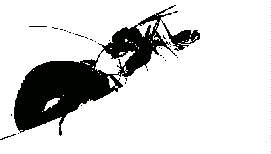 |
The
parasitoid wasp Dinocampus coccinellae is
threatening to cause severe problems to agriculture and
horticulture in Scotland. Studies by Irene Geoghegan of
the Scottish Crop Research Institute in Dundee have shown
that in the Dundee area, up to 70% of the seven spot
ladybird (Coccinella septempunctata) is infested
by this native wasp species. |
by
Anne Bruce
|
(The author would
like to thank Irene Geoghegan, researcher at the Scottish Crop
Research Institute, Dundee for providing materials for this
article and to Andrew Syred for transferring the images to a
digital format.)
The Wasp
Life Cycle
One of the
parasites that infects the British Coccinellidae is D.
coccinellae. It has been found in 13 of the British
ladybirds, irrelevant of size or colour, but the seven spot has
the highest incidence of attack. The two spot (Adalia
bipunctata) and the ten spot (A. decempunctata)
seem to be immune to the wasp and another 8 species are known to
be rarely parasitised.
Male wasps occur
very rarely, the female reproduces by parthenogenesis, laying a
single egg inside her ladybird host. On hatching, usually after
about 5-7 days, the first larval stage is armed with large
mandibles enabling it to remove any eggs or larvae already
present. Once this competition is disposed of, the larval wasp
obtains its first supply of food via specialised trophic cells
which absorb nutrients directly from the ladybird. Later, the
larva feeds directly on its host's fat bodies and gonads.
Having passed
through 4 larval stages (which takes around 18-27 days) the
parasite severs the main nerves to its host's legs. With its host
immobilised, but not dead, the larva then burrows out of the
ladybird and spins a cocoon between the ladybird's legs. This
ensures that the pupating wasp enjoys the protection provided by
the ladybird's bright warning coloration as well as the deterrant
properties of "reflex bleeding"; a mechanism whereby
ladybirds produce toxic and foul tasting fluids from their joints
to put off would be predators.
Pupation takes
about 6-9 days. An hour after the new wasp emerges from the
pointed end of the cocoon she is ready to lay eggs and continue
with the destruction of ladybirds.
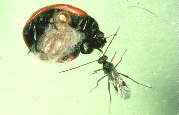
|
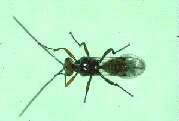
|

|
Adult
wasp emerging from cocoon
|
Wasp (Dinocampus
coccinellae)
|
Seven
Spot ladybird (Coccinella septempunctata)
|
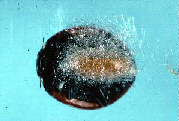
|
Life
History of Dinocampus coccinellae
|
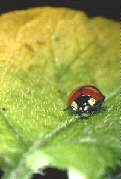
|
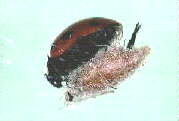
|
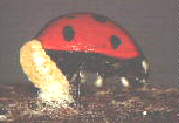
|
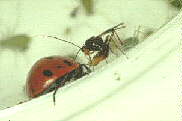
|
Immobilised
ladybird with pupa
|
Larva
about to pupate
|
Wasp
laying egg in ladybird
|
The
implications
A single
wasp can lay at least 100 eggs in a lifetime
There are two
generations of wasp each year in Scotland
A single
female wasp which hatches in the spring has the potential
to cause the infestation of 10,000 ladybirds by the end of that year.
It has been
estimated that a single ladybird can consume 5,500 aphids in its lifespan of one year
As aphids
suck plant sap they transmit numerous plant viruses and
so cause massive losses to crop yields. Ladybirds are
extremely garden and farm friendly as they eat these
damaging plant pests.
So what
is being done about this?
Irene Geoghegan is
so concerned about this alarming threat to agriculture that she
is running a research programme in her own time to attempt to
determine how widespread wasp infestation is in Scotland. Information packs are
being sent out to schools and people are being asked to send live
seven spot ladybirds to Irene so that she can continue the
research programme. The information packs contain many
interesting facts about ladybirds and details as to how the
insects may be sent without harm. Once examined, those ladybirds
free of the parasite will be released into the wild.
Further studies
are being carried out which focus on determining those factors
which influence the wasp's preferences for laying eggs. For
example, results from research already carried out suggest that
female seven spot ladybirds have a higher incidence of
infestation than males.
Nuclear magnetic
resonance (NMR) microscopy is also being used as a technique to
assess interactions between parasite and host. The advantage of
this technique is that it is "non-invasive" it can
therefore be carried out without harming the ladybird. A
comparison of uninfected and infected ladybirds can be seen from
the NMR images below.
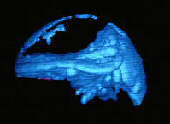 |
Uninfected
ladybird
|
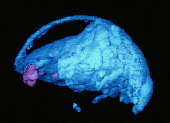 |
Infected
ladybird
The head of
the larva can be seen (pink structure at left side of
image), as can the change in bulk brought about by the
production of trophic cells
|
Comments
on the article to the author Anne
Bruce
If
you live in Scotland and would like an information pack or are
willing to take part in this important piece of research, then
please write to: Irene Geoghegan, Research
Scientist, Scottish Crop Research Institute, Invergowrie, Dundee
DD2 5DA (enclosing a large self addressed
stamped envelope).
© Microscopy UK
or their contributors.
Please report any
Web problems or offer general comments to the Micscape Editor,
via the contact on current Micscape Index.
Micscape is the
on-line monthly magazine of the Microscopy UK web
site at Microscopy-UK
WIDTH=1
© Onview.net Ltd, Microscopy-UK, and all contributors 1995 onwards. All rights
reserved. Main site is at www.microscopy-uk.org.uk with full mirror at www.microscopy-uk.net.










